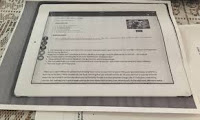Recently Reddit users had a good laugh over a post titled “Mom, you are doing it wrong.” Somebody’s mom was making hard copies of recipes off her iPad by placing the iPad’s screen directly onto the photocopier.
I laughed, too, but a little ruefully. After all, I spend a lot of time helping business enterprises deploy new technology effectively in pursuit of powerful benefits. No matter how exciting those benefits, when people face disruptive change, they tend to bend the new back to the familiar. Mom wants hard copies of her recipes, iPad or no iPad. Users want to keep their old familiar processes, new technology or not.
Not surprisingly, hobbling new technologies with old processes diminishes its benefits. When the benefits do not materialize, users are disillusioned (“We went through all that and this is all it does?) and buyers are flummoxed and unhappy (“Where is my competitive advantage? Where is my savings?”)
Digital revolution
Because the near future will be dominated by disruptive change – in the form of the digital revolution – it’s a good time to focus on this vulnerability of new technology deployments. For example, in the business world, SAP S/4HANA® is one the most powerful enterprise technology platforms supporting that revolution, and is now being embraced across all industry sectors as part of what is being coined 'Industry 4.0'. Its new suite of applications let companies of all sizes take economic advantage of exciting technology advances like Big Data, Internet of Things, Machine learning, AI, Predictive Analytics, Robotic Process Automation, Cloud and Mobile solutions.
Absorb, analyze, and react
Without such a platform which supports in-memory processing and cloud based architecture, companies would drown under the sheer weight of the endless real-time flood of big data coming from the new world of connected enterprise. With the platform, they can not only absorb and analyze the valuable data they receive from a variety of internal or external sources (smart IOT devices, social media feeds, click streams) but more importantly, they can react in real time. Not only can they be made instantly aware of, say, a maintenance issue with their equipment, but even as they are made aware of it, the technology can also be pursuing the appropriate fix using some of Machine learning, AI capabilities. Critical failures are prevented, equipment uptime is maximized, human errors are mitigated.
Yesterday
BUT, that can happen only if, in this example, the maintenance team adapts and enhances their current business processes to permit the technology to exercise its full potential in real-time analytics – if they fully adopt “event stream processing,” a major departure from traditional analytics. Yesterday’s traditional ERP systems would receive and store the data, then prepare it for consumption through ETL (extract transform load) processes, and finally present results and share insights as needed. In an increasing number of situations, these insights are too late.
Today
New technologies like SAP S/4HANA® enables a vastly different, more rapid, and instantly valuable Smart Data streaming process. It starts with stored queries /analysis, then it receives data (from thousands of sensors, electronic commerce sites - both internal and external, and internet-connected devices), then processes the data, and immediately, pushes the results to trigger an appropriate reaction. It is revolutionary, not evolutionary. No matter how fast the data moves, how much data there is, or how many data sources it is being pulled from, it is all under the user’s control via a single, intuitive interface. Users can define patterns and address scenarios from all aspects of the business, enabling them to stay agile and tackle issues as they arise. Properly deployed, it upends old processes.
Challenge
But old processes are comfortable. What if people mistrust the accuracy of the data, or simply find its speed unsettling and imprudent? They do what seems prudent and slow it up. All that real-time data gets batched up and sent around to be reviewed the next day. All those alerts that were supposed to trigger a rapid reaction (“Notify service teams that a vendor shipment is significantly delayed.” or “Shut down pump #4312 and notify maintenance that its pressure has exceeded safety parameters.”) fall on deaf ears until it is too late. And worst of all, the company’s opportunity for competitive advantage goes by the wayside, with all parties wondering what happened.
Thrive
Making the most of new technologies whether at home or in business means adopting a strategic view and taking a radically different approach from the conventional. It requires open mindset to change the ways we have felt comfortable so far, be ready to vest time to learn and upgrade skill sets so we are equipped to use the new tools in right way, and be ready to reap the full benefits in a new, digitally connected world.
It is one thing to use an iPad and a photocopier when all you want is paper recipes, but if we want to thrive in the digital age where disruption seems inevitable, let us cultivate a changed mindset. Time to go and read up on my manuals for our new Instapot, seems to be the rage now!






No comments:
Post a Comment